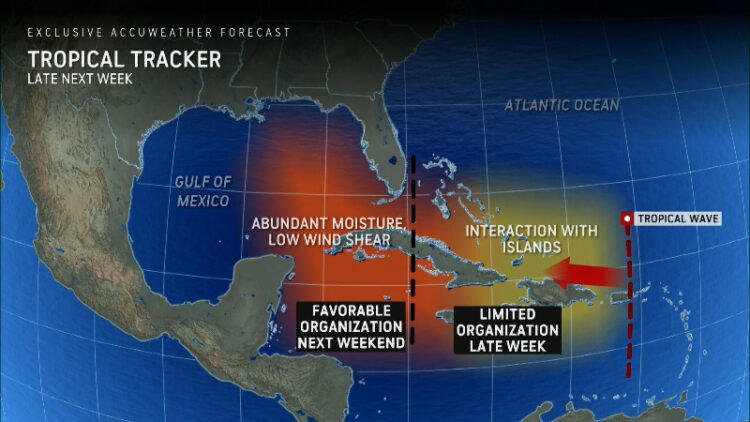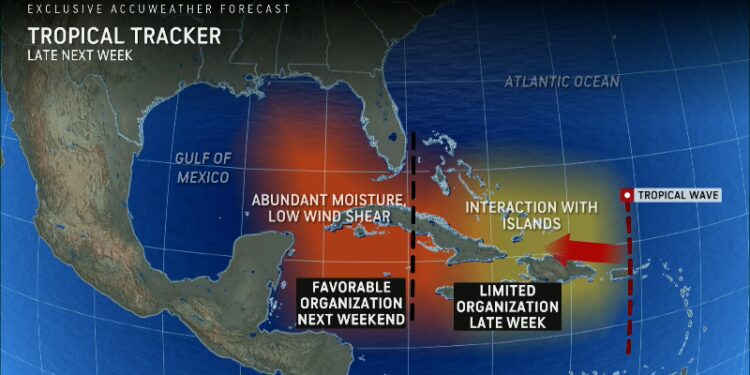
Could another tropical storm be on the way?
Dry, dusty air has prevented tropical development in recent weeks, but forecasters are keeping a close eye on a tropical wave that could be in the Caribbean by the start of August.
In a rush? Here’s everything you need to know — in less than a minute — about what’s happening in the tropics.
The National Hurricane Center has increased the chances for a tropical wave to strengthen as it moves toward Florida and the U.S., according to the latest advisory.
The system now has a 60 percent chance of development over the next seven days and a tropical depression could form late this week, NHC forecasters said.
➤ Track all active storms
AccuWeather meteorologists said there’s a chance the system could become a tropical storm before approaching the U.S. in early August.
Although the colored area may look like the Hurricane’s Center “cone of concern,” the orange area on the agency’s tropical outlook map actually signifies where a tropical cyclone could develop.
Tropical cyclone is the generic term that covers all tropical systems, including tropical depression, tropical storm and hurricane.
If the system does strengthen, the next named storm of the season will be Debby.
Here’s the latest update from the NHC as of 2 a.m. July 30:
A large tropical wave centered several hundred miles east of the Leeward Islands is producing limited shower activity due to dry air aloft.
➤ Excessive rainfall forecast
Environmental conditions are forecast to become more conducive for development over the warmer waters of the southwestern Atlantic Ocean during the next day or two, and a tropical depression could form late this week while the system is in the vicinity of the Greater Antilles or the Bahamas.
Residents in the Greater Antilles, the Bahamas, and the southeastern U.S. should monitor the progress of this system.
Formation chance through 48 hours: low, near 0 percent.Formation chance through 7 days: medium, 60 percent.Storm tracker: Monitor tropical wave as it moves toward Florida
Several factors are in play that will influence whether the tropical wave strengthens and where it will go, according to AccuWeather. Bottom line: Residents in the Caribbean and U.S. should watch it closely and be prepared.
The tropical wave currently is battling dry air and wind shear as it moves west. Both help prevent development or strengthening of tropical systems. That will change toward the end of the week in August, which typically begins the busier portion of the Atlantic hurricane season.
“Toward the end of this week, the wave will move into an area with fairly low shear and ample moisture, and that could allow some organization and strengthening,” said AccuWeather Lead Hurricane Expert Alex DaSilva.
And then there’s a “ripple.” As the tropical wave “interacts with another ripple in the atmosphere early this week,” the two could combine into a single low-pressure area, AccuWeather said.
“Exactly how these two interact and where they re-form as a single storm may determine the future path near the Caribbean this week and perhaps the U.S. beyond,” AccuWeather forecasters said.
Two scenarios mentioned by AccuWeather that could affect the U.S. include:
If the storm tracks north of the big islands in the northern Caribbean later this week, it would more likely be a concern for the East Coast of the U.S.If the storm tracks just south of the big islands, it may be more concerning for the U.S Gulf Coast.
Yet another factor on where the tropical wave could go is a system of high pressure over the Central Atlantic currently moving it to the west. By the weekend and early next week, “steering winds should turn the tropical feature to the northwest or north near the U.S.,” AccuWeather said.
“Everyone from the northern Caribbean to the Bahamas and from the U.S. Gulf Coast to the Carolinas will have to watch this tropical feature closely,” AccuWeather forecasters said.
What does the colored area on the NOAA map mean?
The striped areas on a tropical outlook map indicate “areas where a tropical cyclone — which could be a tropical depression, tropical storm or hurricane — could develop,” said National Hurricane Center Deputy Director Jamie Rhome.
The colors make it visibly clear how likely a system could develop, with yellow being low, orange medium and red high.
The National Hurricane Center generally doesn’t issue tropical advisories until a there is a named storm, but there is an exception.
“If a system is near land and there is potential for development, the National Hurricane Center won’t wait before it issues advisories, even if the system hasn’t become an actual storm. This gives residents time to prepare,” Rhome said.
Who is likely to be impacted?
It’s too early at this time to determine if there will be any impact to Florida or the U.S. from the tropical wave, although no matter where it goes, expect surf and seas to build well in advance of it it along with dangerous rip currents, AccuWeather said.
Forecasters urge all residents to continue monitoring the tropics and to always be prepared. That advice is particularly important for what is expected to be a very active hurricane season.
Weather watches and warnings issued in FloridaWhen is the Atlantic hurricane season?
The Atlantic hurricane season runs from June 1 through Nov. 30.
When is the peak of hurricane season?
The peak of the season is Sept. 10, with the most activity happening between mid-August and mid-October, according to the Hurricane Center.
National Hurricane Center map: What are forecasters watching now?
Systems currently being monitored by the National Hurricane Center include:
Interactive map: Hurricanes, tropical storms that have passed near your cityExcessive rainfall forecastWhat’s next?
We will continue to update our tropical weather coverage daily. Download your local site’s app to ensure you’re always connected to the news. And look for our special subscription offers here.
Source link : https://www.savannahnow.com/story/weather/hurricane/2024/07/30/tropical-depression-or-storm-possible-as-system-moves-toward-florida-us/74598723007/
Author :
Publish date : 2024-07-30 07:31:17
Copyright for syndicated content belongs to the linked Source.




